You’ll need to establish authentic relationships with Indigenous suppliers who prioritize legal acquisition and cultural respect when sourcing traditional materials like turquoise, coral, and shell. Focus on direct partnerships with Native artisans rather than commercial intermediaries to guarantee fair compensation reaches creators. Evaluate materials based on cultural significance, craftsmanship quality, and traditional sourcing practices while following sustainable harvesting protocols that respect ecosystems and seasonal cycles. Understanding these foundational principles opens pathways to deeper cultural connections.
Understanding Traditional Material Sourcing Practices

When you examine traditional Indigenous material sourcing practices, you’ll discover a profound philosophy that intertwines respect for the natural world with cultural preservation.
You’ll find that traditional material sourcing emphasizes utilizing locally available resources like animal hides, seeds, and natural dyes extracted from regional plants. This approach guarantees you’re working with materials that carry deep spiritual significance and environmental harmony.
You’ll notice artisans prioritize culturally meaningful substances such as turquoise, coral, and shell, each symbolizing specific attributes like wisdom, strength, and interconnectedness.
These materials aren’t randomly chosen—they’re carefully selected based on ancestral knowledge and ceremonial importance. When you understand this foundation, you’ll appreciate how traditional material sourcing represents more than mere craftsmanship; it’s a sacred practice connecting generations through sustainable relationships with the earth.
Sacred Stones and Their Cultural Significance
Among the carefully selected materials that carry ancestral knowledge, sacred stones stand as some of the most spiritually powerful elements in Indigenous adornments. These materials don’t just serve decorative purposes—they’re vessels of cultural wisdom and spiritual connection.
| Stone Type | Cultural Significance | Spiritual Properties | Common Uses |
|---|---|---|---|
| Turquoise | Healing and protection | Wisdom and guidance | Jewelry, ceremonial items |
| Coral | Ocean spirit connection | Strength and resilience | Maritime adornments |
| Shell | Universal interconnectedness | Harmony and balance | Sacred ornaments |
When you’re sourcing these sacred stones, you’re handling materials that embody Indigenous values of natural harmony. Ethical sourcing becomes essential—it respects cultural heritage while supporting sustainable community practices. Each stone carries stories, spiritual beliefs, and connections to ancestral traditions that span generations.
Ethical Harvesting of Natural Resources

Building upon the spiritual foundation that sacred stones provide, ethical harvesting of natural resources requires you to approach each material with the same reverence Indigenous communities have maintained for centuries.
You’ll need to establish relationships with reputable suppliers who prioritize legal acquisition and support Native artisans’ livelihoods. When sourcing seeds, stones, and animal hides, you’re participating in cultural practices that honor the land’s resources.
Your selection of gemstones like turquoise and coral should consider their cultural significance within Native American culture while ensuring minimal ecological impact.
Community involvement remains essential throughout ethical harvesting, as it fosters connections between artisans and their heritage, ensuring your sourcing methods align with Indigenous values and sustainable practices.
Sustainable Collection Methods for Organic Materials
You’ll need to follow traditional harvesting protocols that respect both the materials and their ecosystems when collecting organic resources for Indigenous adornments.
Your collection timing must align with seasonal cycles to guarantee plants and other materials can regenerate naturally without depleting local populations.
You can minimize environmental impact by taking only what’s necessary and rotating collection sites to allow recovery periods.
Traditional Harvesting Protocols
When you’re collecting organic materials for traditional adornments, you’ll need to follow time-tested protocols that prioritize ecological balance and spiritual respect.
Traditional harvesting protocols require you to obtain permission from the land and collect only what’s necessary, preserving ecosystem integrity for future generations. You should time your sustainable collection methods with specific seasons or lunar phases, aligning with natural cycles that Indigenous communities have honored for centuries.
Consider implementing the “Three Sisters” approach when cultivating materials, growing corn, beans, and squash together to promote biodiversity.
Your cultural heritage depends on passing down this knowledge through generations, ensuring community involvement in maintaining these respectful practices. By following these protocols, you’ll honor both the spiritual connection to the land and the environmental sustainability that traditional cultures have always valued.
Seasonal Collection Timing
As traditional ecological knowledge guides Indigenous artisans through the natural calendar, each season offers distinct opportunities for collecting premium organic materials that’ll enhance both the quality and spiritual significance of your adornments.
Mastering seasonal collection timing guarantees you’re harvesting at peak condition while supporting ecosystem health.
Your collection efforts align with nature’s rhythms:
- Spring abundance – Gather vibrant plant fibers when they’re most flexible and colorful for weaving.
- Summer ripeness – Collect seeds and berries at their natural peak for premium beadwork materials.
- Autumn preparation – Harvest mature pods and grasses before winter dormancy sets in.
This timing approach doesn’t just improve material quality—it preserves biodiversity and maintains the sustainable practices that’ve supported Indigenous communities for generations, assuring your artistic traditions remain resilient.
Environmental Impact Minimization
Beyond timing your harvests with natural cycles, your collection methods directly determine whether you’re supporting or disrupting the ecosystems that sustain these precious materials.
You’ll need to adopt traditional techniques that prioritize taking only what’s necessary, leaving enough resources for regeneration and wildlife. Focus on harvesting from multiple locations rather than depleting single areas, and rotate your collection sites to allow recovery periods.
When you integrate Indigenous knowledge with modern conservation principles, you’re advancing both cultural preservation and environmental stewardship.
Partner with local environmental organizations to enhance your understanding of sustainable practices. These collaborations strengthen awareness while honoring the cultural significance of traditional materials, ensuring your adornment practices contribute to ecosystem resilience rather than degradation.
Building Relationships With Indigenous Suppliers
When you’re sourcing materials from Indigenous suppliers, you’ll need to focus on establishing authentic partnerships that go beyond simple transactions.
You should prioritize supporting artisan communities by engaging directly with Native creators and understanding the cultural significance behind their materials.
Your ethical sourcing practices must include transparent communication about how you’ll use these materials while respecting traditional knowledge and ensuring fair compensation.
Establishing Authentic Partnerships
Building genuine partnerships with Indigenous suppliers requires you to move beyond transactional relationships and invest in meaningful connections rooted in mutual respect and cultural understanding.
You’ll discover that authentic Native American art emerges when you prioritize direct relationships that honor traditions and practices. Trust develops through understanding cultural context and ensuring your material sourcing aligns with ethical practices and community values.
Creating authentic partnerships means:
- Engaging in open dialogue – Listen actively to artisans’ stories about their craft’s cultural significance and traditional methods
- Providing fair compensation – Support local artists with payments that reflect the true value of their skills and heritage
- Respecting traditional techniques – Source from artisans who demonstrate commitment to ancestral methods rather than mass-produced alternatives
Supporting Artisan Communities
Supporting Indigenous artisan communities means investing in relationships that extend far beyond single purchases or seasonal orders. When you’re supporting artisan communities, you’re directly empowering individuals who carry traditional knowledge and practices that have been passed down through generations.
These partnerships help preserve cultural heritage while creating sustainable economic opportunities within Indigenous communities. Your commitment to cultural respect shows when you take time to understand the stories behind each material and technique.
You’re not just acquiring authentic adornments—you’re participating in the continuation of ancestral traditions. By purchasing directly from artisans, you guarantee fair compensation reaches the creators themselves rather than intermediaries.
This economic support strengthens entire communities, enabling them to maintain their cultural practices while building sustainable livelihoods for future generations.
Ethical Sourcing Practices
Authentic relationships with Indigenous suppliers form the foundation of truly ethical sourcing practices.
When you’re sourcing materials for Native American jewelry, you’ll discover that direct partnerships create mutual respect and understanding. These relationships guarantee materials like turquoise, coral, and shell maintain their cultural significance while supporting artisan livelihoods.
Your commitment to ethical sourcing practices transforms how you approach material acquisition:
- Desert sunsets captured in turquoise – sourced directly from Navajo mines where generations have extracted wisdom’s stone
- Ocean’s protection flowing through coral – gathered sustainably by coastal tribes honoring ancient harvesting traditions
- Interconnected shells whispering stories – collected by Indigenous hands that understand each piece’s sacred meaning
You’re not just purchasing materials; you’re preserving cultural heritage while empowering communities economically and environmentally.
Turquoise Mining and Community Impact
When you examine turquoise mining in the American Southwest, you’ll discover it’s deeply woven into the fabric of Native American communities across Arizona and New Mexico. This vibrant stone provides essential economic opportunities for Indigenous artisans who craft authentic jewelry reflecting their cultural heritage.
You’ll find that turquoise carries profound spiritual significance, symbolizing protection, wisdom, and earth connection for many tribes.
However, you must consider the complex impact on these communities. While mining offers financial resources, it also raises environmental concerns and questions about preserving cultural identity.
When you support ethical sourcing practices, you’re ensuring mining operations respect both Indigenous rights and environmental sustainability. This approach fosters meaningful relationships that honor traditional knowledge while providing economic benefits to Native American communities.
Coral and Shell Procurement From Coastal Regions
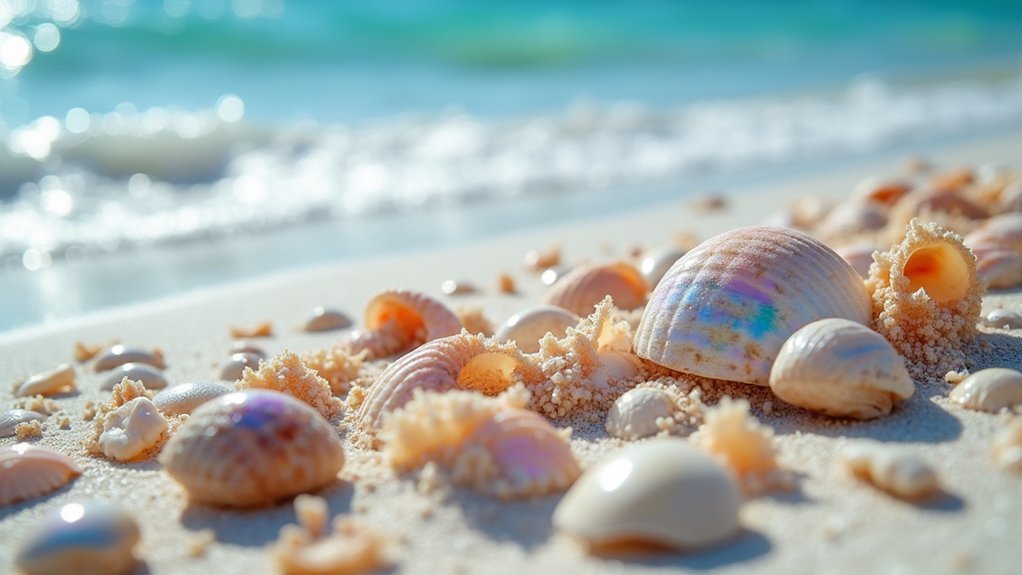
Along the Pacific and Atlantic coastlines, you’ll find vibrant coral reefs and shell-rich waters that provide essential materials for Indigenous jewelry making. These coastal regions hold deep cultural significance, where coral and shell symbolize strength and your connection to nature’s powerful forces.
Coastal waters provide sacred coral and shell materials that connect Indigenous artisans to nature’s enduring strength and cultural heritage.
When you’re sourcing these materials, you’ll need to follow ethical procurement practices that protect marine ecosystems. Indigenous artisans have perfected techniques to transform raw coral and shell into intricate adornments that preserve their cultural heritage.
Consider these vivid imagery elements:
- Crimson and orange coral branches gleaming beneath crystal-clear waters
- Iridescent abalone shells reflecting rainbow patterns on sandy beaches
- Weathered conch shells carved into delicate pendants by skilled hands
Your support empowers these artisans to continue traditional practices while sustaining their livelihoods.
Silver and Metal Sourcing Traditions
Beyond the coastal treasures of coral and shell, Indigenous communities have long mastered the art of working with silver and other metals sourced from their ancestral lands.
You’ll find that these metal sourcing traditions prioritize ethical procurement through local mines and established trade networks, ensuring materials carry deep cultural significance.
When you examine authentic Indigenous jewelry, you’re witnessing techniques like stamping and casting that artisans have perfected over generations.
Each piece tells stories through intricate designs reflecting tribal heritage.
While European contact in the 16th century introduced new metalworking practices, Indigenous artists adapted these innovations while preserving ancestral methods.
Today’s artisans honor these traditions by using recycled metals, demonstrating their commitment to sustainability while maintaining the cultural integrity that makes silver work so meaningful to their communities.
Beadwork Materials and Their Origins
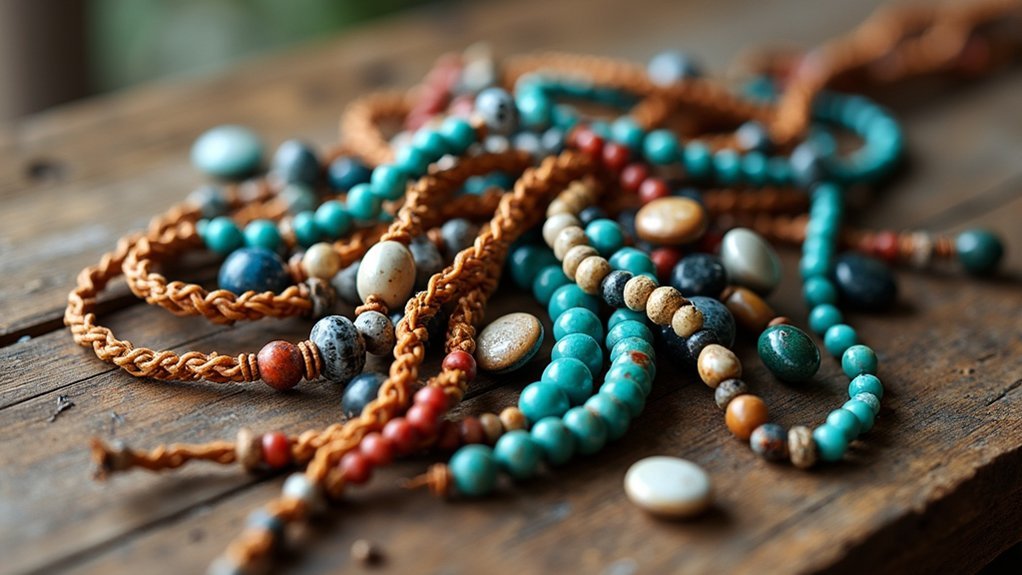
The ancient art of beadwork represents one of humanity’s oldest forms of decorative expression, with Indigenous communities crafting intricate designs from natural materials for over 40,000 years.
You’ll discover that traditional beadwork materials included seeds, stone, and bone before European contact transformed these practices forever.
When European traders arrived in the 15th and 16th centuries, they introduced glass seed beads that revolutionized Indigenous decorative arts.
You can trace how these vibrant materials, combined with steel needles, shifted artisans from quillwork to beadwork techniques.
Today’s ethical sourcing practices emphasize:
- Natural seeds glistening like tiny amber jewels against buckskin
- Polished stones reflecting ancient earth colors in geometric patterns
- Glass beads shimmering in rainbow cascades across traditional garments
Cultural exchanges created distinctive floral designs that blend European influences with Indigenous curvilinear patterns.
Leather and Hide Preparation Techniques
Skilled artisans transform raw animal hides into supple, durable leather through ancient techniques that honor both the animal’s sacrifice and ancestral knowledge. You’ll discover that traditional hide preparation techniques involve careful selection of materials like deer or buffalo hides, each chosen for specific cultural significance and unique qualities.
| Process Stage | Traditional Method |
|---|---|
| Cleaning | Remove flesh and fat with bone scrapers |
| Tanning | Brain tanning or vegetable compounds |
| Stretching | Secure to wooden frames for drying |
| Softening | Work hides while drying repeatedly |
| Finishing | Apply natural plant-based dyes |
Your leather preparation journey requires patience and respect for generational wisdom. These time-honored methods produce materials perfect for clothing, footwear, and ceremonial items while maintaining cultural authenticity and honoring Indigenous heritage.
Plant-Based Dyes and Natural Pigments
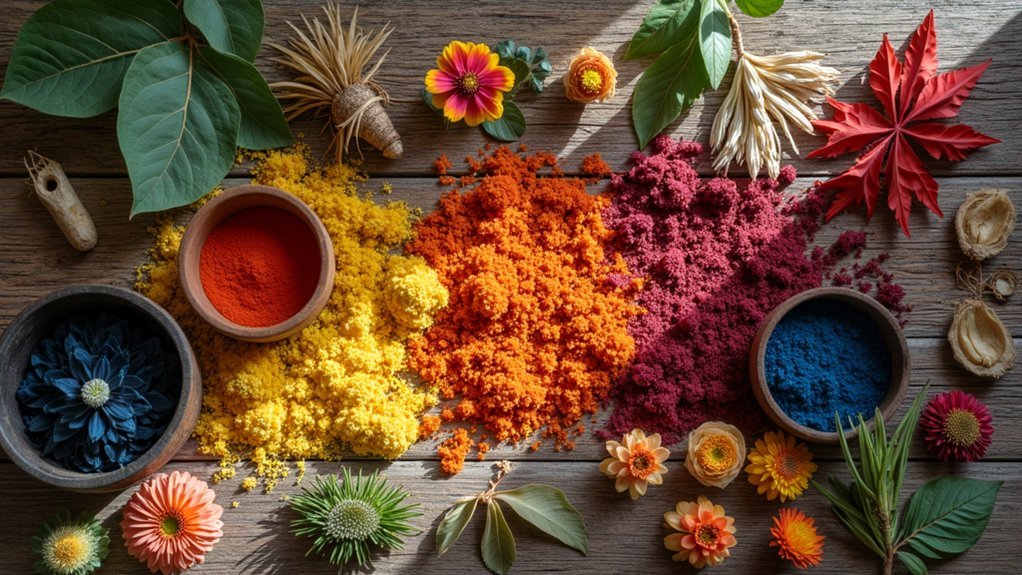
Once you’ve prepared your leather foundation, vibrant colors bring your adornments to life through carefully extracted plant-based dyes and earth-sourced pigments.
Indigenous communities have perfected these ancient techniques over centuries, transforming regional materials into stunning hues that reflect their cultural heritage.
Generations of wisdom flow through time-honored dyeing methods, where ancestral knowledge meets nature’s palette to create meaningful, culturally-rich artistic expressions.
You’ll create authentic colors by harvesting specific plants, roots, and bark from your local environment.
The traditional process involves drying these materials before boiling them to extract their vibrant essences.
Here’s what you’ll gather for authentic coloring:
- Crimson berries crushing between your fingers to release deep red juices that stain textiles permanently
- Golden turmeric roots grinding into fine powder that transforms into brilliant yellow when heated with water
- Charcoal fragments creating rich black pigments that provide striking contrast against natural leather tones
These plant-based dyes guarantee your adornments remain environmentally sustainable while honoring traditional practices.
Supporting Indigenous Artisan Communities
Beyond creating your own dyes, you’ll find that partnering with Indigenous artisan communities enriches your craft while supporting traditional knowledge keepers.
When you purchase directly from Indigenous artisans, you’re providing fair compensation that strengthens their communities’ economic foundations and fosters cultural pride.
You should collaborate with reputable suppliers who work directly with Native American craftspeople to guarantee authenticity in your materials.
This approach maintains the true cultural significance of your adornments while respecting traditional techniques.
Supporting Indigenous artisan communities also means engaging in educational initiatives that promote informed consumer choices.
Quality Assessment of Traditional Materials
When you’re evaluating traditional materials for Indigenous adornments, you’ll need to understand that authentic quality goes far beyond surface appearance. Your appraisal must encompass cultural significance, craftsmanship precision, and material integrity.
Authentic Indigenous adornment appraisal demands deeper understanding than visual assessment—cultural significance and craftsmanship precision matter equally alongside material integrity.
For stones like turquoise and coral, you’re examining:
- Color vibrancy and clarity – Deep, rich hues that reflect the stone’s natural beauty and cultural symbolism.
- Cultural connection authenticity – Ensuring the stone’s origin aligns with traditional sourcing practices and spiritual significance.
- Structural integrity – Testing durability and examining natural formations without artificial enhancements.
When evaluating textiles and beadwork, you’ll inspect pattern intricacy, color consistency, and construction durability.
Each traditional material carries ancestral knowledge, so your appraisal honors both technical excellence and cultural authenticity, ensuring these precious adornments maintain their sacred heritage.
Preserving Cultural Authenticity in Material Selection
When you’re selecting materials for Indigenous adornments, you must prioritize understanding each material’s traditional origins and the specific tribes or regions they’re sacred to.
You’ll need to implement ethical sourcing practices that involve direct partnerships with Indigenous communities rather than third-party dealers who can’t verify cultural provenance.
Your material choices should actively preserve cultural significance by respecting traditional uses, seasonal harvesting practices, and ceremonial restrictions that govern how these materials can be obtained and used.
Traditional Material Origins
You’ll find authentic adornments crafted from materials that connect directly to the land and its creatures:
- Animal hides and bone – transformed into leather work, carved ornaments, and structural elements for jewelry
- Seeds, stones, and shells – carefully selected for their natural colors, textures, and symbolic meanings
- Plant fibers and quills – woven into intricate patterns that tell stories and represent tribal identity
Each material represents a sacred relationship between Indigenous communities and their ancestral territories.
This makes authentic sourcing essential for preserving cultural integrity.
Ethical Sourcing Practices
Understanding where materials come from marks only the beginning of responsible acquisition.
You’ll find that ethical sourcing practices require building direct relationships with Native American artisans and suppliers who legally obtain their materials while honoring cultural traditions.
When you’re selecting turquoise, coral, and shell, you’re choosing materials that embody wisdom, strength, and nature’s interconnectedness.
You should focus on each stone’s unique color, pattern, and texture to enhance both aesthetic appeal and cultural significance.
By committing to these ethical sourcing practices, you’re supporting Indigenous artisans’ livelihoods and helping them preserve their craft and heritage.
Your transparency in sourcing builds customer trust, as today’s consumers increasingly seek authentic products that truly reflect Native American artistry and traditions.
Cultural Significance Preservation
Since each stone and shell carries generations of cultural meaning, preserving this significance requires careful attention to how materials connect with Indigenous traditions.
You’re not just selecting decorative elements—you’re choosing pieces that embody sacred stories and ancestral wisdom.
When you source materials authentically, you’ll guarantee the heritage of Native American communities remains intact through:
- Deep turquoise mines reflecting desert skies where ceremonies honored earth’s gifts
- Coral branches echoing ocean prayers passed down through coastal tribal generations
- Silver veins mirroring moonlit paths walked by ancestors during spiritual journeys
Your material choices directly impact whether cultural narratives survive or fade.
By understanding each element’s traditional role, you’ll create adornments that honor Indigenous identity rather than appropriating it.
Authentic sourcing means respecting the sacred connection between materials and their cultural origins.
Frequently Asked Questions
What Materials Are Used in Native American Jewelry?
You’ll find turquoise symbolizing wisdom and protection, coral representing ocean spirit and strength, plus shell materials symbolizing interconnectedness. Native American artisans hand-cut, shape, and polish these stones using traditional techniques passed down through generations.
What Materials Are Used in Indigenous Art and Regalia?
You’ll find indigenous art and regalia incorporate animal hides, feathers, shells, glass beads, porcupine quills, copper, turquoise, coral, wool, cotton, and seeds. These materials carry deep cultural significance and reflect spiritual beliefs passed down through generations.
How Did European Contact Impact Native North American Adornment?
You witnessed dramatic changes when Europeans introduced glass beads, steel needles, and trade cloth, transforming your traditional quillwork into vibrant beadwork while creating new economic opportunities through floral designs.
What Materials Did Indigenous People Use?
You’d find indigenous people using animal hides, tree bark, porcupine quills, stones, shells, seeds, and bones for their adornments. They’d craft these natural materials into decorative items long before European trade introduced glass beads.
In Summary
You’ve learned that sourcing indigenous materials requires deep respect, ethical practices, and genuine partnerships with native communities. Don’t approach this as mere shopping—you’re participating in cultural preservation. Build authentic relationships with indigenous suppliers, understand the sacred significance of materials, and guarantee your purchases directly support artisan communities. Your choices can either honor or exploit traditional knowledge. Choose wisely, source responsibly, and always prioritize cultural authenticity over convenience.

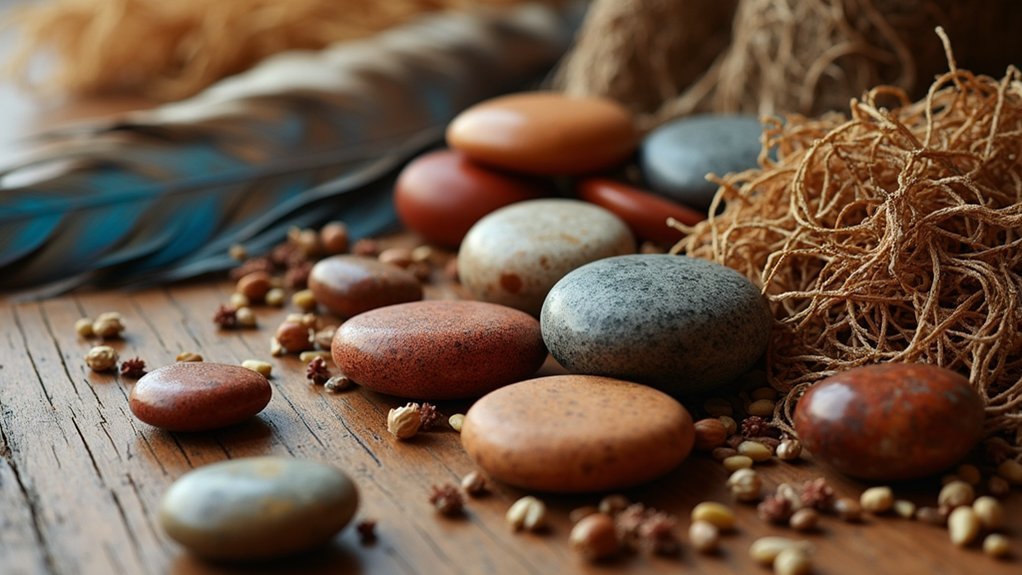
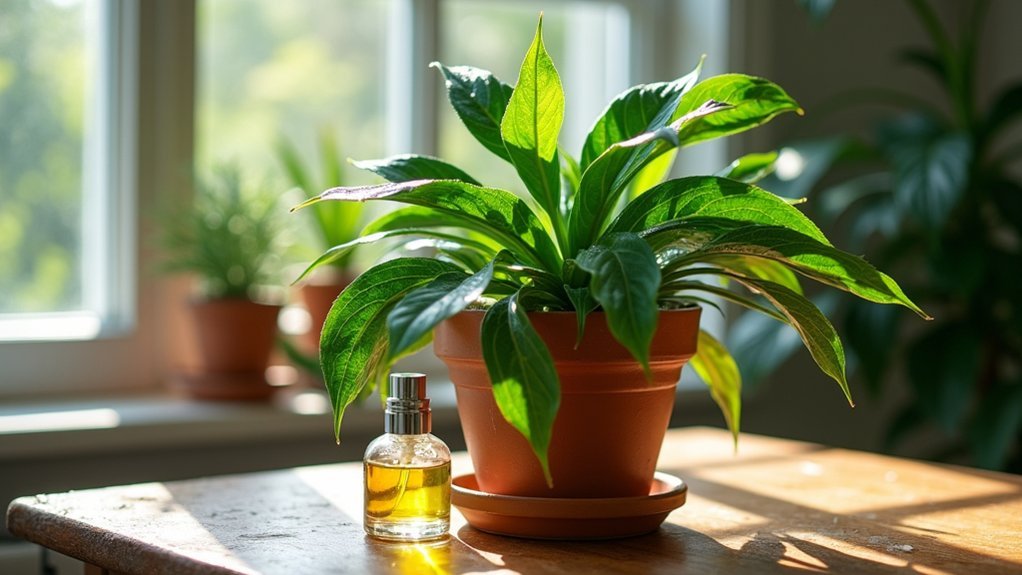


Leave a Reply